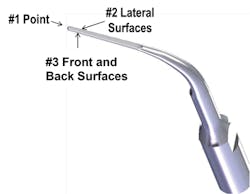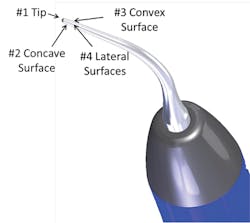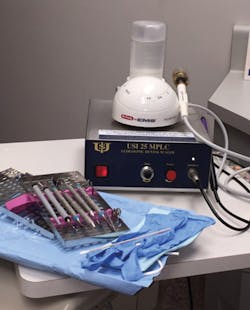Another tool in your toolbox: Why choose between power scaler technologies?
By Nancy Miller, RDH, BA
As an instructor in power instrumentation, I am often asked which ultrasonic scaling technology is superior or my favorite to use. When I suggest that both technologies have advantages and that I actually use both in my treatment room, I am often greeted with an incredulous look from the questioner as though I just grew a third eye!
It seems to be a paradigm shift to consider having two ultrasonic units available for use. But consider the doctors' variety of handpieces: slow speed or high speed, air driven or electric turbine, special drivers for implants or endodontics, and other features or characteristics. Just as a craftsman has many tools in the toolbox to best address the problem at hand, we in dentistry should consider having a variety of tools in our own toolboxes to get the best results for whatever procedure we are performing.
Power instruments for dental hygiene procedures include scalers and air polishers. Current research is showing the effectiveness of biofilm removal with air polishers using glycine powder. Much is being written on this topic, and there are a couple of units on the market that actually have power scalers and the air polisher combined in one unit casing. However, the majority of devices are standalone units. While biofilm and some stains can be removed with an air polisher, hard deposits such as calculus and stain imbedded in calculus cannot. We continue to need power scalers for this task, and I feel both kinds of ultrasonic technology are valuable for our selection of tools.
Ultrasonic Scalers
Ultrasonic scalers are available with two movement-generation technologies: magnetostrictive or piezoelectric. Air-driven scalers that attach to the dental unit airline hose are not in the ultrasonic category. These are sonic devices in the 3,000-8,000 hertz range (1 hertz = one cycle per second, 1,000 cycles equals one kilohertz, KZ), and they aren't very powerful. They vibrate in a circular movement that can "roll over" hard deposits and emit a very annoying shriek that is in the human audible range. Although their portability is attractive, daylong use of these is not.
Magnetostrictive scaling units use a working tip attached to a stack of metal nickel plates called an insert/tip. The insert/tip is placed into the handpiece which has a coil in its length. When electricity is applied, a magnetic field is created that generates vibrations in the metal stack.
These vibrations are called frequency and refer to the number of times per second that the tip moves back and forth during one cycle (one complete stroke path). Frequency levels are usually in the 25,000-30,000 hertz range (thus 25K or 30K devices), and the magnetostrictive tip motion is somewhat elliptical in nature. This creates a "rolling" motion on the hard surface, which can be comfortable but also can burnish old calculus that has accumulated and embedded itself in the cementum or root surface. All sides of the tip come into play, with the point having the most power, the front and the back being the most active, and the sides being the least active (see Figure 1).
Figure 1
Constant movement of the working end is recommended for the most efficient use and removal of plaque and biofilm, but contact against a hard deposit has to be engaged long enough to cause microfractures for breakup and removal. The point of the tip can create a fracture in a large deposit of calculus, causing it to shatter and break apart. A hard deposit will break apart in pieces, and stain removal is accomplished by using crisscrossing, crosshatching strokes until the last small stain is gone.
Tactile sensitivity is somewhat diminished by the weight and bulk of the metal stacks in the handpiece, but this can be improved with operator practice and thinner inserts. Water is needed as a coolant since the stacks generate heat during operation.
Piezoelectric devices use stacked ceramic plates or quartz crystals in the handpiece to generate a linear motion similar to a reciprocating saw or electric knife movement. The tips are threaded and wrenched into position at the end of the handpiece.
Figure 2
The linear movement (see Figure 2) creates a shaving motion on the calculus, which can lend itself to more thorough burnished calculus removal with very little finger pressure. Think of how an electric knife moves, and that correlates to the linear motion of the tip. Piezoelectric movement against a hard deposit shaves it into minute pieces that seem to make the deposit "melt" away.
Although most literature indicates only the sides of the tip work, under load (activated and put against a surface) piezoelectrical tip movement is also elliptical and there is some action occurring on the front and back surfaces.1 The front and the back will make more noise when in contact with a hard tooth surface but not have as much activity as the sides.
As a lot of the tips for piezoelectric devices are designed like hand instruments, and there is no metal stack in the handpiece, tactile sensitivity tends to be enhanced. The working edge is positioned and used in a similar fashion to hand instruments, and because of that it is often easier for operators to adapt to.
Less water is needed as the handle does not need to be cooled like the stacks in the magnetostrictive units. This can enhance water evacuation control issues and lower the amount of aggravating mist and water on the mirror face.
I like the ease of old calculus removal via the piezoelectric reciprocating saw motion. A piezo tip that has a ridge or edge on it instead of one that is round in the cross-section combined with a back and forth motion in the cycles creates a shaving effect. I can actually feel the calculus being shaved off the surface stroke by stroke.
There are many sizes, shapes, and styles of piezo tips to choose from depending on the task at hand. Tip geometry becomes important in selection depending upon the task: a round- or oval-shaped cross-section for biofilm removal or triangular or square for hard deposits. Some of the piezoelectric handpieces have LED lights that enhance visibility.
I like the magnetostrictive tips' ability to use the more dormant lateral sides against the cementoenamel junction (CEJ) areas on the buccal and lingual where there is usually less deposit accumulation and more sensitivity. By minutely repositioning the tip in the interproximal area to adapt the active front and back on the surfaces that tend to have more calculus and biofilm, I can smoothly complete a quadrant. The ability to do this "roll" around the line angles of a tooth and to smoothly enter and exit interproximal areas is a big benefit of magnetostrictive inserts.
Hu-Friedy has its line of Swivel tips that actually give you control of that movement at your fingertips, which is optimal for ease. Dentsply has a new unit out called the Cavitron Touch that now has a swivel built into the handpiece at the fingertip area that promises to be a useful feature. Parkell has a new magnetostrictive unit that has a lighted LED handpiece with special inserts that channel the light to the tip area.
Both kinds of ultrasonic scaling technologies will only be as effective for treatment as the person's skill level who uses them. A thorough understanding of root anatomy for subgingival debridement, and using a root surface explorer such as the Hu-Friedy 11/12 Old Dominion University Explorer to ensure complete instrumentation of hard deposits and plaque is indicated.
Figure 3 Quick disconnect splitter
Creative Tools
When I assess my patient to determine what tools I'll need to complete treatment, I like to have on hand what I deem necessary and most efficient. Therefore, I had an engineer friend devise a "splitter" quick-disconnect adaptor (see Figure 3) so I can have both scaling units attached to my one water source on the dental unit. I simply stack one on top of the other and I am good to go (see Figure 4).
I have a newer EMS unit with a self-contained water source so I no longer need the splitter device, but if you choose a piezo unit that is without a water pump, it could be helpful for you.
In one case, the patient exhibited generalized bone loss due to an orthodontic intervention that left her with an open bite. There are no pockets over 2mms, but generalized recession with over 4-5mm of attachement loss and moderate new calculus and stain. This exposes a lot of root surface that can be more sensitive.
I chose my magnetostrictive unit with a Hu-Friedy Swivel 100 insert as I wanted to use rapid strokes over all of the surfaces. The ability to rotate this insert in my fingertips lets me use all the sides of the tip on the facial, lingual, and interproximal surfaces with one smooth, rolling motion. The movement of the front and back of the working end gently broke up the deposits and stains with little effort on my part other than proper tip movement and adaptation. The application of the less active sides to the more sensitive lingual and buccal surfaces is easily facilitated by the swivel action and the tip geometry, which has an oval cross-section.
Figure 4 Piezo EMS-Hu-Friedy250 and Magnetostrictive USI 25MPLC
The following is a recent clinical scenario in which I chose to use my piezoelectric unit. A new patient presented with little recession or pockets, but older supragingival and some subgingival calculus, particularly on the distals of the lower and upper second molars. I like to tease that this is that "chunky monkey" calculus that we are all familiar with in those areas. I chose my piezo unit with a UPE3 perio tip that looks like a universal curette, and applied its edges to the deposits with a slower, stroking motion that "shaved" the deposits until deposit removal was complete and the surface was smooth. I describe the scaling of these deposits with the curette tip "like a hot knife going through butter." This tip has a rounded toe, which makes inserting it in the interproximal areas easier; it has a rectangular cross-section profile so there are definite edges for the ultrasonic energy to concentrate on for effectiveness.
Could I accomplish both tasks with either technology? Certainly, but I believe it is easier and more complete with my previously mentioned selections. That is why I like having a choice in my technologies, so I can deliver the best options for care.
Until my engineer colleagues devise a generator that will allow a piezoelectric handpiece and a magnetostrictive handpiece to come from the same generator box in one unit, I will continue to "pile up" my tools for easy access. If you already have a magnetostrictive unit in your toolbox, consider adding a piezoelectric device to your selection, or vice versa. Having one does not preclude the ability to have the other, and treatment options will be increased. RDH
Nancy Miller, RDH, BA, has, since 1992, presented lectures and hands-on courses on topics such as ultrasonic instrumentation and air flow therapy for biofilm removal, ergonomics, assisted hygiene, and periodontal and caries disease treatment through her company Ultraconcepts. She still practices two days weekly in a general practice in Green Bay, Wis. She also has been a dental practice management advisor with Jameson Management since 1998, specializing in clinical department coordination with the business team. Nancy is also product evaluator for several manufacturers including Crown Seating, Hu-Friedy, Perioptix, and Florida Probe.
References
1. Lea, Walmsley, et al. Journal of Clin Perio. 2008.




